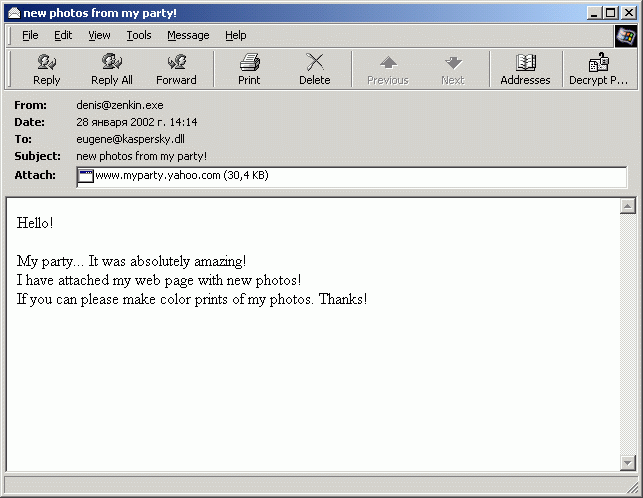Parent class: VirWare
Viruses and worms are malicious programs that self-replicate on computers or via computer networks without the user being aware; each subsequent copy of such malicious programs is also able to self-replicate. Malicious programs which spread via networks or infect remote machines when commanded to do so by the “owner” (e.g. Backdoors) or programs that create multiple copies that are unable to self-replicate are not part of the Viruses and Worms subclass. The main characteristic used to determine whether or not a program is classified as a separate behaviour within the Viruses and Worms subclass is how the program propagates (i.e. how the malicious program spreads copies of itself via local or network resources.) Most known worms are spread as files sent as email attachments, via a link to a web or FTP resource, via a link sent in an ICQ or IRC message, via P2P file sharing networks etc. Some worms spread as network packets; these directly penetrate the computer memory, and the worm code is then activated. Worms use the following techniques to penetrate remote computers and launch copies of themselves: social engineering (for example, an email message suggesting the user opens an attached file), exploiting network configuration errors (such as copying to a fully accessible disk), and exploiting loopholes in operating system and application security. Viruses can be divided in accordance with the method used to infect a computer:- file viruses
- boot sector viruses
- macro viruses
- script viruses
Class: Email-Worm
Email-Worms spread via email. The worm sends a copy of itself as an attachment to an email message or a link to its file on a network resource (e.g. a URL to an infected file on a compromised website or a hacker-owned website). In the first case, the worm code activates when the infected attachment is opened (launched). In the second case, the code is activated when the link to the infected file is opened. In both case, the result is the same: the worm code is activated. Email-Worms use a range of methods to send infected emails. The most common are: using a direct connection to a SMTP server using the email directory built into the worm’s code using MS Outlook services using Windows MAPI functions. Email-Worms use a number of different sources to find email addresses to which infected emails will be sent: the address book in MS Outlook a WAB address database .txt files stored on the hard drive: the worm can identify which strings in text files are email addresses emails in the inbox (some Email-Worms even “reply” to emails found in the inbox) Many Email-Worms use more than one of the sources listed above. There are also other sources of email addresses, such as address books associated with web-based email services.Read more
Platform: Win32
Win32 is an API on Windows NT-based operating systems (Windows XP, Windows 7, etc.) that supports execution of 32-bit applications. One of the most widespread programming platforms in the world.Description
This is a virus-worm that spreads via the Internet attached to infected e-mail. The worm itself is a Windows PE EXE file about 30Kb in length (compressed by UPX, 76K decompressed), and it is written in Microsoft Visual C++.
Infected messages appear as follows:

The worm activates from infected e-mail only when a user double-clicks on the attached file. The worm then installs itself to the system and runs a spreading routine.
Installing
While installing, the worm copies itself to:
and spawns this copy. When the worm's file name is not ".com" (as in the attachment),
but rather ".exe" (the worm is re-named), it also opens the Web page
"http://www.disney.com".
The original file (as it was run from an infected e-mail) is moved to the Recylced or
Recycler directory with one of the following names:
where %1, %2, %3 are randomly selected numbers, for example:
While installing, the worm checks the keyboard layouot set, and when there
is Russian keyboard support, the worm copies itself to Recycled/Recycler in the
same way and exits. This is the same on any date except for 25-29 January 2002.
As a result, the worm works only from 25 until 29 January 2002, and only on machines
without Russian keyboard support.
Spreading The worm also sends one e-mail (without an attachment) to "napster@gala.net".
Backdoor
Under WinNT/2000/... the worm also creates a new file in a user's auto-run directory:
and writes a backdoor program to there. This backdoor is run by data
that are stored in a file at the Web site "http://209.151.250.170".
Known Variants
Myparty.b
This one is a slightly modified 'a' version. The differences are:
Find out the statistics of the vulnerabilities spreading in your region on statistics.securelist.com
c:recycledregctrl.exe - under WinNT/2K/XP
C:RECYCLERF-%1-%2-%3
C:RECYCLEDF-%1-%2-%3
F-12158-19044-21300
F-27729-23255-31008
%Userprofile%Start MenuProgramsStartupmsstask.exe
The attached file name is "myparty.photos.yahoo.com".
Read more